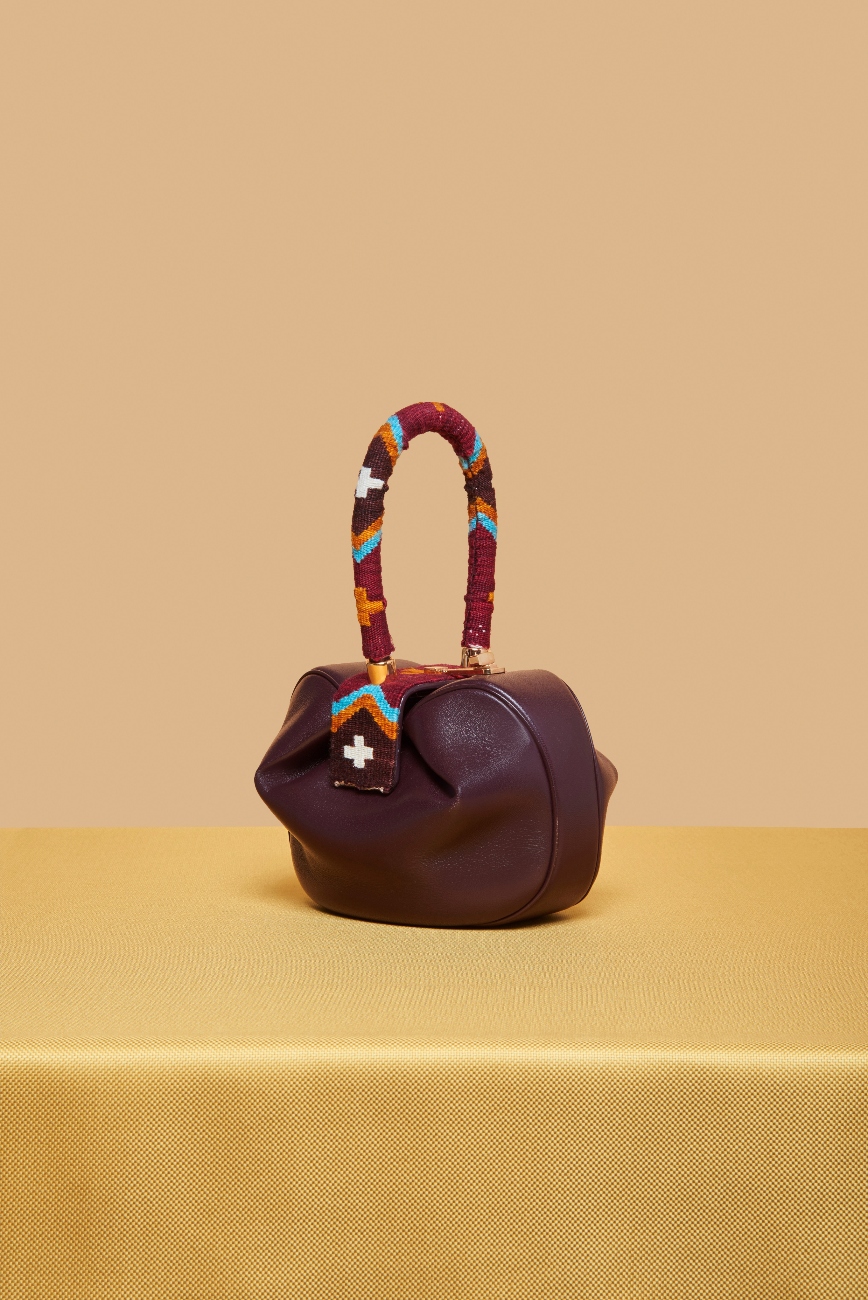Luxurious manufacturers are more and more collaborating with Indigenous communities in significant methods, transferring past superficial aesthetic inspiration to have interaction in real partnerships. Extra manufacturers are incorporating Indigenous assets, textiles, supplies and narratives into their creations, making certain that Indigenous data and craftsmanship will not be merely referenced however actively credited and revered. Consistent with Earth Day 2025, LUXUO explores how luxurious manufacturers are shifting towards moral sourcing and manufacturing by involving Indigenous communities within the creation of their merchandise. From uncooked supplies and textiles to historical strategies and cultural storytelling, manufacturers are working to raise Indigenous voices and traditions, providing a deeper connection between luxurious and sustainability.
Ralph Lauren x Naiomi Glasses
In December 2023, Ralph Lauren launched the primary assortment from its Artist in Residence program, partnering with Naiomi Glasses, a seventh-generation Diné (Navajo) textile artist and weaver. This collaboration marked a big step within the model’s ongoing dedication to broaden its portrayal of America’s various cultures, with a selected concentrate on Indigenous craftsmanship. The Polo Ralph Lauren x Naiomi Glasses assortment celebrates conventional Navajo weaving strategies whereas introducing them to a up to date viewers. Impressed by the landscapes of Navajo Nation, the designs function woven jacquard blanket coats, ranch coats and jackets alongside trendy interpretations of basic Ralph Lauren types. Motifs equivalent to Navajo spider lady crosses, four-directional crosses and dragonfly patterns mirror the intricate artistry and cultural symbolism woven into each bit. Going past style the marketing campaign was led by indigenous creatives, together with photographers Ryan RedCorn (Osage) and Daryn Sells (Diné/Navajo), and directed by Shaandiin Tome (Diné/Navajo). The marketing campaign highlights Glasses’ journey with Navajo weaving, mixing cultural heritage with Ralph Lauren’s luxurious aesthetic. A portion of proceeds from the gathering will profit Change Labs, a Native-led group supporting Navajo and Hopi entrepreneurs, furthering Ralph Lauren’s dedication to empowering Native communities via schooling, enterprise growth and cultural preservation.
Some critics have identified that luxurious manufacturers have traditionally appropriated Indigenous prints and textiles with out correct recognition or respect for his or her cultural significance. By partnering with Naiomi Glasses, Ralph Lauren is making an attempt to “cowl their bases” – nonetheless utilising Indigenous designs however doing so with a aware effort to acknowledge and have fun the artistry behind them.
Johnstons of Elgin – Sustainable Cashmere Sourcing from Mongolian Herders


Johnstons of Elgin’s dedication to sustainability is obvious of their sourcing of cashmere from Mongolia, a area the place the huge grasslands are threatened by overgrazing and local weather change. As a founding member of the Sustainable Fibre Alliance (SFA), the model collaborates instantly with Mongolian goat herders to handle these environmental challenges. By combining trendy sustainability practices with conventional nomadic strategies, they assist herders in preserving each the land and their centuries-old cultural practices. One in every of their key initiatives is the “Haraacai” course, which teaches younger herders sustainable grazing strategies, mixing regenerative practices with Mongolian traditions. This coaching is significant for the subsequent technology, because it empowers them to change into stewards of their atmosphere. The course’s influence is rising, with over 400 college students graduating in its first yr. By way of their SFA partnership, Johnstons of Elgin ensures full traceability of the cashmere provide chain, with a aim to supply one hundred pc of their cashmere from licensed, sustainable sources by 2024. Their work highlights the significance of safeguarding each the livelihood of herding communities and the fragile ecosystems of Mongolia’s grasslands, making certain a sustainable future for generations to return.
Gabriela Hearst


For her Spring/Summer time 2022 assortment, Gabriela Hearst labored instantly with Navajo artisans, together with fifth-generation weaver TahNibaa Naataanii, who raises Churro sheep and makes use of conventional plant-based dyeing strategies, making certain Indigenous data is embedded within the manufacturing course of. The collaboration was coordinated via Judy Campbell-Clancy, who connects Navajo craftspeople with significant work, addressing excessive unemployment and lack of infrastructure on the reservation. Diné filmmaker and activist Krystal Curley documented the method, additional rooting the venture in Indigenous storytelling. Hearst additionally labored with women-led craft collectives in Bolivia and Uruguay, and partnered with Clergerie in France to supply footwear utilizing handwoven Moroccan raffia and sustainable cork, reinforcing her dedication to moral, culturally embedded luxurious manufacturing. . Crucially, the gathering additionally challenged tokenistic illustration by giving Indigenous makers narrative management via movie and direct credit score.
Dior’s Collaboration with Mexican Artisans


For Dior’s 2024 Cruise assortment, the posh Maison collaborated with indigenous artisan communities throughout Mexico, working instantly with weavers and embroiderers from areas together with Oaxaca, Puebla, and Chiapas. The initiative was coordinated by native specialists and cultural practitioners equivalent to Remigio Mestas, Hilán Cruz, Narcy Morales and Pedro Meza, who introduced collectively multi-generational craftspeople expert in ancestral strategies — from pure dyeing to conventional embroidery and weaving. These collaborations weren’t surface-level. Dior’s inventive director, Maria Grazia Chiuri, built-in Indigenous textile data into the gathering’s core designs, co-developing clothes with native artisans. The end result was a collection of items — huipils, gabans, skirts and attire — that showcased not simply couture gildings however the handmade experience of communities just like the Zapotec of San Blas Atempa, the Mixtec of San Pablo Tijaltepec, and the Mayan ladies weavers of Los Altos de Chiapas. These weren’t outsourced reproductions however site-specific productions led by native coordinators, the place artisans contributed to design choices, approach software and materials choice. By working instantly with Indigenous artisans as co-creators relatively than merely referencing their aesthetics, Dior fostered a mannequin of collaboration that centred native data and authorship, providing visibility to particular people and their craft traditions.
Burberry’s Cashmere Initiative in Afghanistan


By way of its basis, Burberry has partnered with Oxfam and PUR Projet on a long-term initiative to assist Afghanistan’s cashmere trade — a serious however typically missed supply for luxurious provide chains. Regardless of being the world’s third-largest producer of cashmere, Afghan herders have traditionally lacked entry to assets, coaching and truthful market buildings. This five-year programme affords schooling in sustainable harvesting, livestock care and pasture administration, whereas additionally serving to communities kind producer teams to strengthen their place within the provide chain. Burberry’s work not solely helps higher high quality yields and fairer pricing, but additionally goals to stabilise a area deeply affected by battle and local weather change. The model is participating native authorities and trade gamers to create insurance policies that may increase the worth of Afghan cashmere globally. The programme is actively contributing in the direction of UN Sustainable Growth Objectives 1, 4, 5, 8, 9 and 17, which embrace ending poverty in all its kinds, making certain inclusive and equitable schooling for all, attaining gender equality and selling sustained and sustainable financial development.
Zegna’s ACHILLFARM™ in Australia


Zegna’s possession of ACHILLFARM™ in New South Wales displays a uncommon degree of vertical integration within the luxurious trade — one the place uncooked materials manufacturing is instantly managed from the supply. The two,500-hectare farm is house to round 10,000 Merino sheep, bred and raised to supply ultra-fine wool for Zegna’s tailoring. This hands-on method permits the Italian home to supervise every part from pasture circumstances to animal welfare, reinforcing its long-term funding in wool as a core id materials. Whereas the ACHILLFARM™ mannequin doesn’t contain Indigenous Australian communities instantly, it reveals how Zegna has taken on agricultural stewardship as a part of its traceability efforts. By controlling fibre origins and committing to regenerative practices, the model positions itself as each producer and innovator. This enhances its parallel environmental initiative, Oasi Zegna, an enormous reforested space within the Italian Alps, which underpins the model’s broader dedication to sustainability, biodiversity, and neighborhood.
Loro Piana Collaboration With Seneca Nation’s Marie Watt

As a part of its ongoing engagement with Indigenous communities, Loro Piana collaborated with Seneca Nation artist Marie Watt, whose work displays her Iroquois heritage and explores the intersection of collective reminiscence, storytelling, and textile traditions. Primarily based in Portland, Oregon, Watt is thought for incorporating reclaimed materials and community-driven narratives into her observe, typically utilizing blankets as a medium to discover shared histories. For Loro Piana, Watt created a site-specific set up on the model’s New York flagship, bringing Indigenous views into the center of its retail house. This collaboration displays Loro Piana’s rising recognition of the cultural and ecological origins of its supplies. Identified for sourcing uncommon fibres like vicuña and child cashmere, the model has labored with communities in Peru, Mongolia and the Andes, investing in schooling, animal welfare, and environmental safety. The Watt set up marks a step towards not simply moral sourcing, however cultural reciprocity — acknowledging the individuals, traditions and land behind the supplies luxurious so typically depends on.
For extra on the most recent in luxurious fashion and enterprise reads, click on right here.


